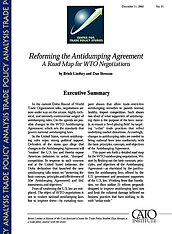In the United States, current antidumping rules enjoy strong political support. Defenders of the status quo allege that changes to the Antidumping Agreement will “weaken” the U.S. law and thereby expose American industries to unfair, “dumped” competition. In response to such concerns and at the United States’ insistence, the Doha declaration that launched the new antidumping talks insists on “preserving the basic concepts, principles and effectiveness of [the Antidumping Agreement] and [its] instruments and objectives.”
Fears of weakening the U.S. law are misplaced. The object of WTO negotiations is not to weaken national antidumping laws but to improve them–by curtailing rampant abuses that allow trade-restrictive antidumping remedies to punish normal, healthy, import competition. Such abuses run afoul of what supporters of antidumping claim is the purpose of the laws: namely, to ensure a “level playing field” by targeting “unfair” trade practices that reflect underlying market distortions. Accordingly, changes to antidumping rules are needed to bring national practice into conformity with the “basic principles, concepts, and objectives” of the Antidumping Agreement.
This paper sets forth a detailed road map for the WTO antidumping negotiations. We start by fleshing out the basic concepts, principles, and objectives of the Antidumping Agreement–as elucidated by the justifications for antidumping laws offered by the U.S. government and prominent supporters of the U.S. law. Working from that foundation, we then outline 21 reform proposals designed to improve antidumping laws’ aim and limit the collateral damage inflicted on business practices that have nothing to do with “unfair trade.”



